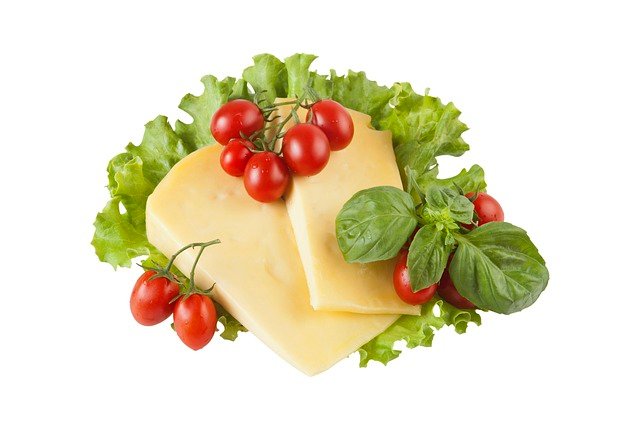Cheddar comes from England and is today the most consumed cheese in the world. It is made from cow’s milk. The addition of annatto gives it its orange color, essential in burgers. White Cheddar Cheese is one of the cheeses richest in lipids but also has nutritional benefits.
Characteristics of Cheddar
- Rich in well-absorbed calcium.
- Good Source of protein.
- Good Source of phosphorus.
- Source of selenium and zinc with antioxidant functions.
- Rich in sodium.
- Source of vitamin A for good vision.

Nutritional and Caloric values of Cheddar
Cheddar is rich in nutrients; it is caloric but devoid of lactose. For 100g of Cheddar:
Nutrients | Average content |
Calories (kcal) | 401 |
Water (in g) | 37.1 |
Protein (in g) | 23.6 |
Carbohydrates (in g) | traces |
Lipids (in g) | 33.8 of which AGS: 19.5 MUFA: 8.67 PUFA: 1.38 Cholesterol: 102 mg |
Iron (in mg) | 0.16 |
Calcium (in mg) | 675 |
Phosphorus (in mg) | 473 |
Sodium (in mg) | 644 |
Selenium (in microg) | 11.1 |
Zinc (in mg) | 3.43 |
Retinol (in microg) | 256 |
The benefits of Cheddar
Cheddar, very rich in lipids, is a high-calorie cheese. However, it is not without its interests. It is also lactose-free. Although the recommended portion is 40g, the intake should be addressed.
Source of Calcium for good bone growth
Known for their high calcium contents, hard cheeses, including Cheddar, are recommended for people with increased calcium needs. Children, adolescents, breastfeeding women, and people with osteoporosis should put Cheddar on the menu. In addition, the calcium present in Cheddar is particularly well absorbed by the body. Indeed, cheddar benefits from an adequate calcium/phosphorus ratio. Calcium is involved in bone and dental mineralization. 1% of the calcium absorbed plays a so-called “catalytic” role in nerve impulses’ conduction and muscle contraction. That is why it is included in nutritious food.
Proteins for muscles
Proteins are macronutrients involved in all physiological mechanisms. White cheddar cheese, with more than 20 g per 100 g, is a good source (even if we must put it into perspective knowing that the recommended quantity consumed is 40g). Cheddar contains good-quality proteins since they comprise all the essential amino acids. They contribute to the growth and maintenance of lean mass. In addition, they are necessary for elderly subjects who often suffer from sarcopenia and prevent malnutrition as well as the complications linked to it. Antibodies are protein structures; proteins thus play a role in immunity and enzymatic and hormonal reactions.

Selenium and Zinc for immunity
Cheddar cheese is well supplied with selenium; this trace element contributes to the proper functioning of the immune system. Selenium is also an antioxidant that blocks free radicals; antioxidants slow the premature aging of cells, helping to prevent certain cancers, type 2 diabetes, and age-related degeneration. Cheddar cheese contains 11 microns of zinc, which contributes to immune function.
Sodium for Homeostasis but not only
Like most cheeses, Cheddar is rich in sodium and, therefore, salt (400 mg of sodium = 1g). Sodium allows the maintenance of homeostasis and cellular exchanges; the only downside is its overconsumption, which increases the risk of developing cardiovascular pathologies.
Source of vitamin A
Cheddar contains retinol (vitamin A), which contributes to good twilight vision and stimulates melanin synthesis, a protective pigment against harmful UV rays.
A word from the Nutritionist
Cheddar is one of the cheeses to be included regularly in the menu; however, rich in lipids, notably saturated acids and salt, its consumption must respect the recommended quantity and frequency. It is also known as nutrition food.
Advice when purchasing
I prefer cut Cheddar. For cheese lovers, opt for farmhouse cheddar, a relatively high-end Cheddar with solid aromas.
Store well
Cheddar will be kept in the refrigerator for several days.

How to use Cheddar in cooking?
Cheddar finds its place as an aperitif in all meals, dishes, starters, and salads.
In comfort food
The traditional typically American macaroni and cheese gratin, no burger and fries without Cheddar, the Grated Cheddar can also be sprinkled on a portion of fries or potatoes.
In a lighter version
The diced Cheddar and the raw vegetables in your summer salads will spice up your cauliflower gratins.
As an aperitif
Make gougers, small cheddar shortbreads, fruit and skewers, mini salmon, and cheddar bagels.
Contraindications and allergies to Cheddar
Given the sodium content of Cheddar, people suffering from heart or kidney failure should seek advice from their doctor. People suffering from cow’s milk protein allergies should not consume Cheddar. Finally, pregnant women should avoid consuming Cheddar and pasteurized cheese to prevent health risks.
Eating Munching, is a haven for food enthusiasts and culinary adventurers alike. We are passionate about all things related to food, and our platform is dedicated to sharing the joy and excitement of exploring diverse cuisines from around the world.



